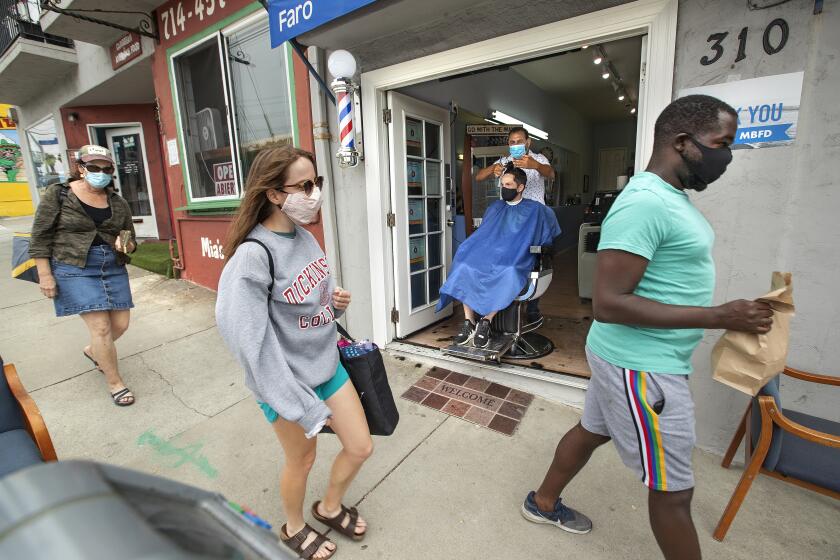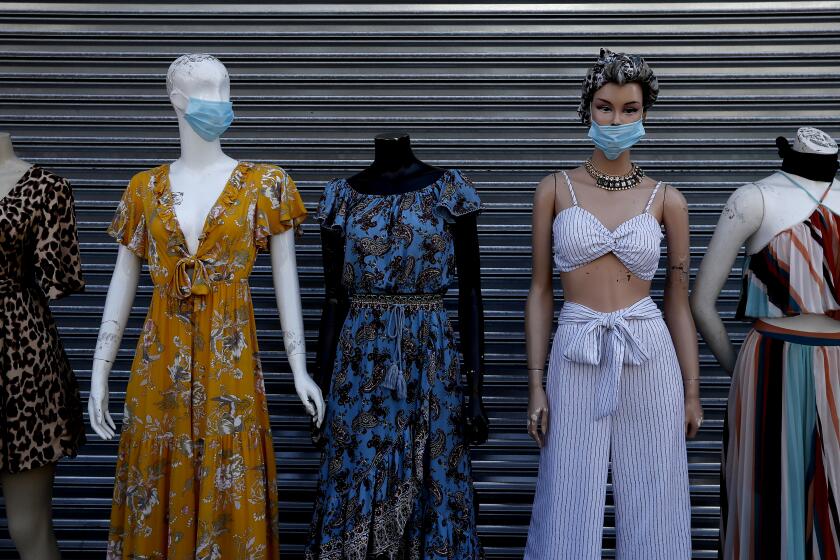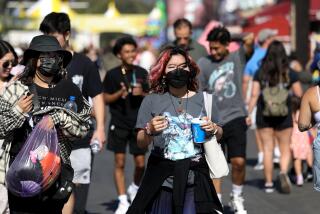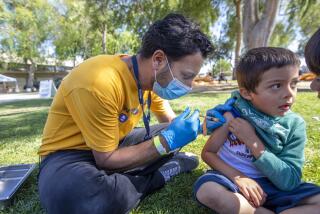At least 1,000 L.A. County restaurants not following coronavirus safety rules, inspections show
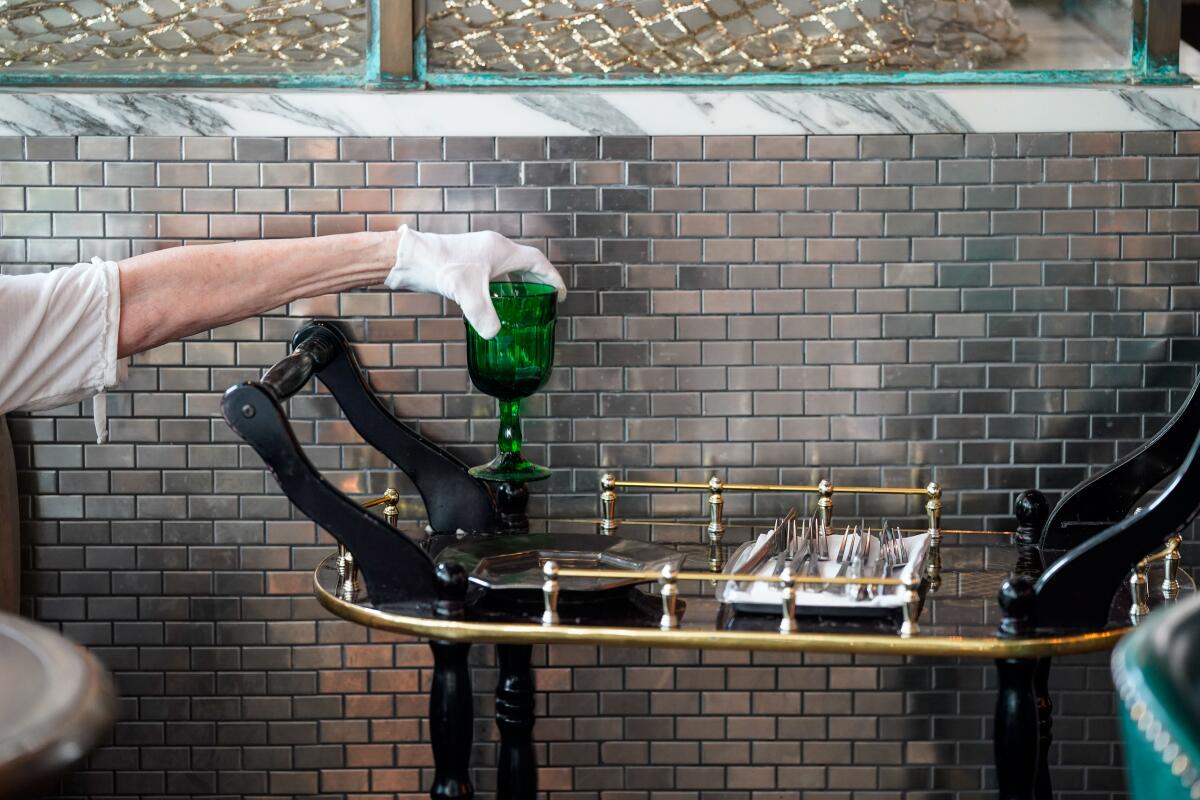
- Share via
As more sectors of the economy are poised to reopen in Los Angeles County this week, public health officials visited some of the establishments that are already open to check whether they are meeting the county’s requirements to do business.
Officials visited roughly 2,000 restaurants over the weekend and found that half of them were not in compliance with the county’s guidelines.
Health officials expressed alarm at the findings, stressing it is essential that both customers and merchants follow safety guidelines to avoid new coronavirus outbreaks as the economy reopens. California has allowed businesses to reopen at a rapid clip, leading to concerns from some that this could cause the virus to spread more. Although the number of cases continues to rise, officials have said they think it is safe to reopen as long as everyone obeys the rules.
“There should be no places where tables are right next to each other,” Public Health Director Barbara Ferrer said Monday.
Restaurants that violated the orders will be revisited, and patrons who notice potential risks at eateries can lodge a complaint via a public health department hotline.
The findings come amid a continued rise in coronavirus cases in California, which reported record tallies on consecutive days last week.
But the spike still does not account for tens of thousands of people who have attended protests over the past few weeks across the state, many demanding police reforms in the wake of George Floyd’s death.
Trying to get a handle on how California is reopening and what it means for you? Our guide includes updates and tips for remaining healthy and sane.
That’s largely due to the fact that people do not typically get tested for the virus before evidence of symptoms, which can take up to 14 days to appear, and because of the lag time between testing and reported results.
It is possible, however, that this week’s case counts will include numbers from the protests, which began after Floyd’s death on May 25. But there’s no way for officials to concretely determine whether cases will spread at the protests because contact tracers do not identify cases that have stemmed from public spaces, which include protests, indoor malls and restaurants.
“We don’t have any way of tracking that information,” Public Health Director Barbara Ferrer said Monday about the difficulty in pinpointing the exact path of transmission from public areas.
On Monday, there were more than 152,000 COVID-19 infections and over 5,000 deaths related to the virus in the state. Nearly half of the number of cases are in Los Angeles County, which also accounts for nearly 60% of all deaths. Officials reported Monday an additional 19 deaths and 1,071 cases in the county.
Instead, officials are encouraging residents to take a proactive approach. Protesters and anyone who has attended a large gathering in recent weeks, especially those who came into contact with a person not wearing a face mask for more than 15 minutes, have been encouraged to get tested for the virus. Though many protesters have worn face masks, it is nearly impossible to avoid coming in contact with crowds.
In the absence of a vaccine and medical therapies, testing is still one of the biggest weapons in preventing the spread of COVID-19. In L.A. County, more than 803,000 tests have been conducted. Of those tested, 8% have been positive for the virus. It’s unclear how many individuals have been tested for the virus because people can be tested multiple times.
Gov. Gavin Newsom said Monday that the state continues to make progress in the fight, but warned that the virus remains a threat.
“We are not out of the woods,” he said.
Dr. Mark Ghaly, the state’s secretary of Health and Human Services, said Friday that overall case counts are not necessarily a measure of how the state is faring in its fight against the novel coronavirus.
“We’ve ramped up testing in an extraordinary way, nearly hitting our goal that was set for August — not June, not July, but August — of getting to 60,000 to 80,000 tests a day,” Ghaly said. “We’re already knocking on that door, averaging in the mid- to high 50s over the past few days across the state.”
Instead, officials are closely monitoring the positivity rate, which is the proportion of people who have tested positive out of all those who have been tested, and the daily number of hospitalizations. The latter is a number that officials worry may increase amid the state’s continued reopening.
Furthermore, Ghaly said the openings are not the source of the increased cases, noting that increased testing can drive up the number of cases as more infections are identified among those who are not seriously ill.
Los Angeles County is one of 13 counties that state officials are closely monitoring for an increase in transmission or a surge in hospitalizations. The county reported an increase in the transmission rate of the virus and warned that hospitals could become overwhelmed in the next few weeks. Such a surge has already hit other states that previously lifted stay-at-home restrictions.
According to an Associated Press analysis, Texas recently set a new record with hospitalized COVID-19 patients. In Arizona, a surge in new cases and hospitalizations occurred about 10 days after the state lifted its stay-home orders.
More to Read
Sign up for Essential California
The most important California stories and recommendations in your inbox every morning.
You may occasionally receive promotional content from the Los Angeles Times.
